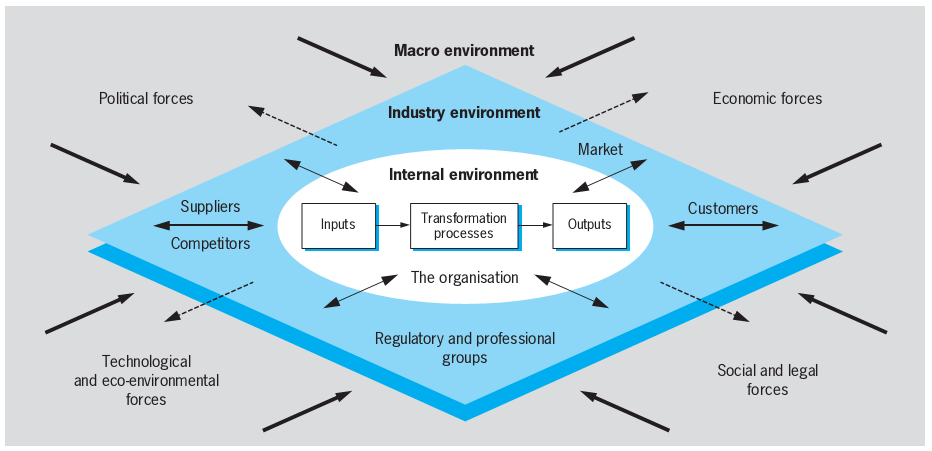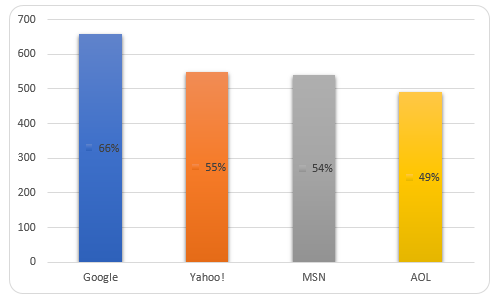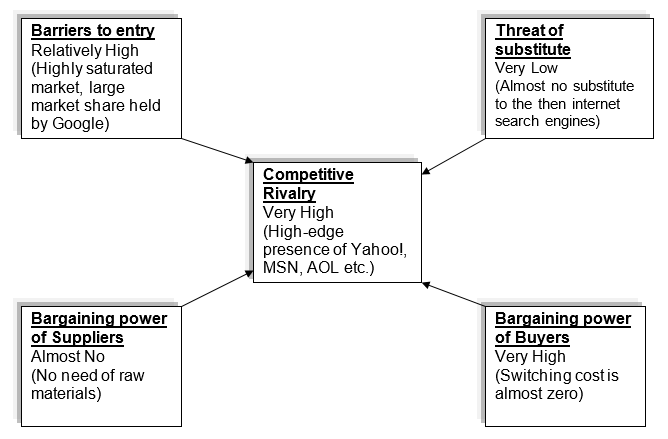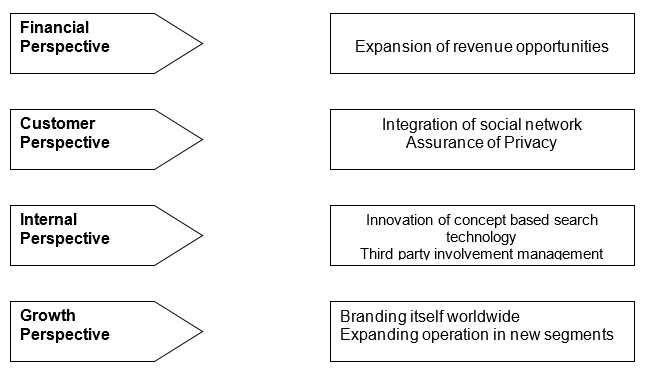Page, L., & Brin, S., the two PhD students of Stanford University, founded Google, the internet search engine giant across the globe, in 1998. The search technology used by Google is thought the finest, efficient and effective search technology ever made. Google provides the least wrong search results in comparison with other search engines. Therefore, approximately 80% of all searches on internet are done by using Google, the google.com. Most prominently, the search engine has various languages compatibility. That is, non-English people can search information over internet by using their own languages. According to the case, the search engine was embedded with the capability of using 88 different languages in 2004. Now a day it has over 100 languages compatibility.
Google offered advertising solutions, international internet search solutions, through its portal that means the computing domicile site for a web browser on the internet that provides links to other eminence widespread web pages with diverse functions. Google, Inc. now has various diverse services namely internet search engine, Google Finance, Google Blog search, YouTube, Google Checkout, Google words, Google spreadsheets, Gmail, Google Toolbar, AdWords, AdSense, Google Earth, Page Creator, and Orkut etc.
Problem Statement
Developing an effective differentiating enterprise-wide strategy for the company’s internet search segment to enable Google, itself, to survive and prosper against aggressive competition in the intermediate and long-term future. That is, finding out the ways to further differentiate Google’s internet search segment, from competitors namely Yahoo!, AOL, MSN etc to achieve a successful edge within the intense competitive environment. Because the environment was changing in the immediate, intermediate, and long-term time frames.
Analysis of the Problem
To analyze the problem stated above, it is required to analyze the business environment and the industry condition in which Google was doing its business. The major strengths, weaknesses, opportunities, and threats of Google also demand a rigorous and analytical description.
External Business Environment of Google
Robbins and Coulter (2003) defined that the external business environment means outsiders such as different kind of forces and institutions who have ability(s) to influence and affect the organization’s performance when the PEST analysis which is termed as a tool to look at outsiders of any organization those has profound impacts on its performances. The PEST incorporates social forces named Political (P), Economical (E), Social (S), and Technological (T)-

Political Factor
The political environment of Google was not a highly controlled one. There were almost no laws and regulations about the internet search engine and their privacy policies. Therefore, the internet search engine corporations had their own ways to operate their businesses. However, to protect intellectual property on internet, there was an evolvement of law.
Economical Factor
The internet usage rate has increased due to increase in the disposable income. More and more people used the search engines for their shopping purposes. These organizations needed to implement new technologies in their operations as the internet traffic rose up. On the other hand, Google experienced a very high growth in terms of its stock market performance; the price of its stocks rose up very rapidly.
Social Factor
Google faced several socio-cultural constraints in then period. It happened due to the interface of its search engine. Because it had a very plain interface, without any animation. Therefore, it was required that the Google should have interfaces based on socio-culture factors across the globe.
Technological Factor
Continuous innovation and improvement of search engine technologies were the handiest activities of these organizations. Internet direct advertising for Google was the key to earn dollars on internet. The innovation of new search engine technologies demanded a high skilled employee base and a handsome research and development budget.
Porter’s Five Forces Analysis of the Internet Search Engine Industry
Michel C. Porter’s five forces model is usually used to make an overview about any particular industry. Google was an internet service provider industry and following are the brief statement of the industry:
Competitive Rivalry
Competitive rivalry of Google in present time is very high because almost all the competitors operated closely in terms of dollar value. According to the case study of Google, for the fiscal year ended 31st December, 2004 Yahoo!’s revenues was $3.57 billion and net income of the same was $839.6 million with growth rates of 110.19% and 252.92%, respectively. The AOL’s revenue rose by 6% and net income rose by 2% for the same time.
The MSN’s revenue rose by 9% and its net income rose by 44% for the same period. As a market share leader of the industry Google’s operating income totaled $321 million for the same period with an overall revenue growth rate 233.50%. Therefore, it is clear that the highly saturated market was in an intense competitive environment among these key players. The loyalty of searchers also stated same type of competitive picture as the following:

Threat of Substitute
Threat of substitute in the industry was very low because there was no clear and prominent substitute of these search engines. However, the vertical search engines were the substitutes. The search engines under the study were usually horizontal search engines and therefore, were the most consumed search engine service provider. Since, the vertical search engines were specialized in any single field only, therefore were not prominent.
Barriers to Entry
The barriers to entry to the industry were relatively low though, there were no regulatory restrictions to enter the industry, but there were the giants to saturate the market. Google is the market leader in terms of its internet search technology and other giants were innovated the same. The giant such as Microsoft was also not able to get superiority over the Google’s technology. For the lack of master technology, entrance to the industry was very hard.
Bargaining Power of Suppliers
Bargaining power of suppliers was almost zero because no raw materials were required. The corporations were developing their own technologies in house and through their own people. Only third parties but not the suppliers have some power to exercise.
Bargaining Power of Buyers
The bargaining power of buyers is very high because there is almost no switching cost. However, in terms of advertising segment it is relatively high because, there are switching costs associated with. Therefore, grabbing patrons, users as termed in the case, is the hard task to be done.

SWOT Analysis of Google
SWOT analysis is a tool to assess an organization’s strengths, weaknesses, opportunities and threats. SWOT analysis is also used to determine the organization’s strategies to gain its end goals. In the following section, the SWOT of Google is described to check how the organization was shaped in the market and how to make it a better one.
Strengths
Strongest market positioning and brand equity
Google was the market leader in the internet search segment and it was providing almost 88 languages. Dierkes, M., and Yen, T., (2005) argued that it was used for 47% of total searches in 2004. Moreover, the being of Google, it is the market leader and its brand equity is the main strength of this company. According to the case, it had a market share amount 31% in the USA internet search traffic.

Unparallel advertising technology
Google had the two advertisements technologies, completely unparallel to competitors, namely AdWords and AdSense, were the revenue generating sources for Google. It was able to place an advertisement campaign on internet within 15 minutes with an initial cost of $5 as stated in the case.
Largest internet search engine across the globe
Google was using almost 100 domains for its internet search engine segment and thus had the highest searching capability. According to the case, it had 1.5 million URLs in its directory.
Proclamation as the most efficient search engine
The users proclaimed it as the most efficient search engine because of its lowest search errors and search hits.

Weaknesses
Weak presence in social networking
Google had not focused on its consumers and their socio-cultural effects. Moreover, by enabling it to have a social networking system would make it able to have more consumer related information for the advertisements.
Product integration problem
There were also problems with product integration because products of Google were not line extended rather were category extended. Therefore, it was problem for its consumers to recognize Google’s services.
Less relevant search hits
There was a problem of Google that it was not able to extract relevant search hits. For example, if anyone searched “Sociology”, it could extract only “sociology”. However, there might be relevant topics on sociology, which were not extracted by the search engine.
Opportunities
- Trumpet growth in computer literacy in underdeveloped countries: worldwide, the computer literacy was growing very rapidly.
- Trumpet growth in internet usage: internet usage growth in USA was tremendous and so did in China, India etc.
- Advertising opportunities: the internet marketing, later termed as e-commerce was evolving very rapidly. Moreover, since people used internet more rapidly therefore, advertisers targeted internet as advertisement medium. Thus, Google’s growth was to evolve further.
- Increase of niche market: since the customers wanted personalized products and services, therefore there was an increase of niche markets. Google could target these niche markets for its AdWords and AdSense.
Threats
- Rapid growth of Microsoft and Yahoo: the Microsoft’s Vista was a threat for Google as stated in the case. Various non-search related services of Yahoo! and AOL also possessed threat for Google.
- Socio-cultural resistance: Google was reluctant to focus on customers and their socio-cultural factors. Therefore, socio-cultural resistances threatened Google across the world. For instance, Chinese people were not using Google.com because of its plain interface.
- Click frauds: as Google was using “click by impression” in its advertisement policy, there were threats of fraudulent clicks. Therefore, advertisers, the customers of Google, might resistant to place their advertisements.
- Legal verdicts on privacy issues: Google was using its member’s mails to add up advertisement according to the mail’s subject. It was a privacy threat for the Gmail users. As a result, thereby legal verdicts were thought to arise.
Strategic Options to the Problems
From the analyses stated above, the following strategies could be thought as the solutions to the Google’s problem. The strategic options stated below are the alternatives to the possible solutions to the Google’s problem.
- Innovation of new technologies to be associative with the present technology;
- Integration of new services to the basic service as complement services.
Action Plan
If the strategic choices are plotted in the strategic map, then it would be further clear what the strategic options to be fulfilled and how to be fulfilled. According to Value Based Management Net (2009) a strategy Map is a diagram that describes how an organization creates value by connecting strategic objectives in explicit cause-and-effect relationship with each other in the four BSC objectives (financial, customer, processes, learning and growth).

Financial perspective
Expansion of revenue opportunities: Google achieve the cost minimization; therefore, revenue opportunities’ has increased and it would help for further expansion the profitability of the organization.
Customer perspective
- Integration of social network: to acquire more customer base, Google might have a social network which would work twofold. Firstly, it would build a rigorous customer information database. Secondly, it would automatically promote Google through word of mouth communication.
- Assurance of privacy: assurance of privacy has to be promoted first. Because since people knew that Google used to extract data from their personal e-mail for advertisement purpose, it was frightening news to them. Therefore, for having numerous networked people, Google have to convince customers about its privacy policy.
Internal Perspective
- Innovation of concept based search technology: according to Lu, F., et al (2008), this concept depends on search technology uses rule which base tree for data retrieval. It is used to generate relevant search hits. That is, it enables to extract all the relevant results to a certain search keyword. It reduces time and effort of the searcher to find every relevant result to their preferred search.
- Third party involvement management: The main reason of Yahoo!’s growth is the proper involvement and management of third-parties to its operations. According to the case, it was one of the key competencies of Yahoo!. Therefore, for being competitively sustainable, Google had to manage its third-parties with care and should have control over these third parties.
Growth Perspective
Branding worldwide
Google had been a prominent brand in USA. But it had to be such prominent in other countries mostly in China, India because, these countries are over populated. If Google grabbed these markets, it would have more profitability. For instance, in China, Yahoo! was prominent and had the most market share. Therefore, to grab market share in these countries, it need to focus on customers and on their societies.
Expanding operation in new segments
Non-search categories of services were the keys of success for the Yahoo!, AOL and MSN. Therefore, for further growth of Google it also have to incorporate other services such video streaming, artificial intelligence to be a substitute of ask.com etc.
Google, the internet search engine giant, needed to focus on its consumers for its further growth in then period. The legal and regulatory concerns would have to be the policy of Google and Google has to comply with the above described strategic options and have to take clear decisions to differentiate it from the emerging and emerged competitors and it should follow approaches to adopt these company-wide strategies. These would ensure the organization’s trumpet growth in the intermediate and long-term future.
Bibliography:
Anon., 2009, The Environment Scan- Environmental Organizational Scanning. Web.
DataMonitor, 2008, Goole, Inc.: Comapany profile. Web.
Download-it. 2008, Business Environment: The organization in context. Web.
Lu, F., Johnsten, T., Raghavan, V., & Traylor, D., 2008, Enhancing Internet Search Engines to Achieve Concept-based Retrieval. Web.
Nymark, L., & Ramazan, S., 2008, Search engine marketin on google: the level of effectiveness and efficiency of AdWords. Web.
Robbins, S., & Coulter, M., 2003, Management, 7th edition, India: Prentice-hall of India Private Limited.
Schumacher, J., Thomas, C., Mack, F., & Bell, J., 2009, Strategic Analysis: Google (GOOG). Web.
Wong, T., & Kim, G., 2005, One in Three Americans Use a Search Engine, According To Nielsen//Netratings. Web.
